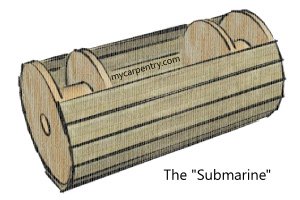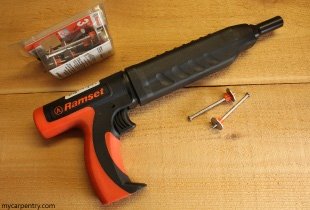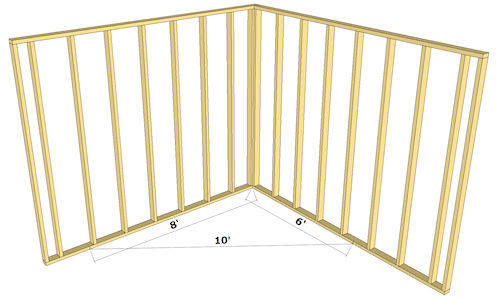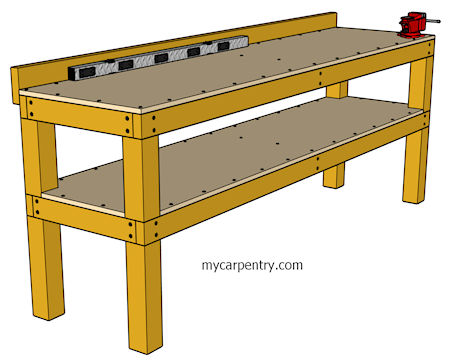First Carpentry Job
This title is a chapter from a memoir I'm writing about my life as a carpenter—the experiences that inspired mycarpentry.com. While mycarpentry.com is about carpentry, these chapters are about the carpenter.
***
I landed my first carpentry job in the spring of a year in the early 1980s. Two men were building a small two-story house when I joined the team.
My previous job was working on-call as a phlebotomist at a hospital in Austin. One day, a patient had their room's thermostat set as high as it would go. Sweat dripped down my face as I struggled to find a vein in her arm. After I drew the blood and labeled the samples, I walked over to the patient's sixth-floor window to take in the view. It was a gorgeous, warm spring day. Groundskeepers were cutting grass and trimming the hedges of the hospital's landscape below. I daydreamed about what it must be like to work outside in the fresh air and sunshine.
After a couple of weeks, I decided to take a break from phlebotomy and look for a job in the carpentry field. I drove to a convenience store to pick up a newspaper to check the ads for carpentry jobs. One of my best friends had recently found a summer job as a trim carpenter's helper. Maybe I could also? I found an ad in the paper that read, CARPENTER'S HELPER WANTED - NORTH AUSTIN - NO EXPERIENCE NECESSARY.
I called the number in the ad and spoke to a fellow named Tim. He began an over-the-phone interview.
"Do you have any carpentry experience?"
"No," I said.
"That's okay. It isn't required. Do you have transportation?"
"Yes, I have a Volkswagen Van."
I'm sure he didn't care what kind of vehicle I drove. He just wanted to make sure I had a way to get my butt to work every day. He gave me the address of the job site and told me to be there at 7 am, ready for work.
My First Carpentry Job - Day 1
It was a typical warm early-summer morning in central Texas. Since dressing for the cold was not a requirement, I wore blue jean cutoffs, a T-shirt, and white leather tennis shoes to work.
I met Tim and a guy named Jeff at the job site.
"Jeff, show Matt how to roll out the tools."
Jeff picked up a pancake air compressor from the back of Tim's truck and carried it across the job site to a temporary power pole. It was common practice to connect the compressor close to the power source to prevent damage to the electric motor due to voltage drop from long extension cords.
"Matt, get two air hoses out of Tim's truck and run them from the compressor to the two nail guns placed on the wooden scaffolding."
After I attached the air hoses to the nail guns, Jeff and I stretched two extension cords from the power pole; one to Tim's saw and cutting area and the other to a jam-box radio that blared rock-n-roll music all day.
The structure of the new two-story house was almost complete, right up to the roof decking, which was already nailed and trimmed. Scrap lumber, siding, and an assortment of nails littered the dry, cracked ground surrounding the house. I began to imagine the slew of woodworking projects I could build from the cuttings: birdhouses, dog houses, wood crafts, and whatever else I could think of.
"Matt!" Tim yelled. "Don't just stand there. Go get some 2x4s from the stockpile and put them on my sawhorses!"
Tim had a unique management style. He yelled, and the crew jumped. No matter. It was time to get some good work in before the Texas sun began to rise and heat up the day. Tim strapped on his nail bags and started cutting wood. The high-pitched buzz of his circular saw temporarily drowned out the music of Stairway to Heaven on the radio while the aroma of fresh-sawn pine filled the morning air.
Since I didn't have any tools, Tim handed me a cloth nail bag to get me started. He gave me the job of installing joist hangers on the garage's ceiling joists that were butt-attached to the garage door header. That should be an easy task, I thought. I saw a box of joist hangers on the garage floor next to a small brown paper sack with the points of nails poking through. I filled my apron with fasteners, grabbed a handful of joist hangers, moved a step ladder over to the first joist, and went to work. I stuck a few nails in my mouth for convenience (and because it seemed like the thing to do).
"Get those nails out of your mouth!" Tim hollered. "Just grab one or two nails at a time from your pouch and get more when you need them! Don't EVER put nails in your mouth!!"
I was embarrassed that I had made such an unfavorable impression after only one hour on the job. Tim was right, though. Nails are rusty, dusty, and covered with coatings and who-knows-what and shouldn't ever be in a person's mouth.
After I installed the Joist Hangers, Tim told me to climb the scaffolding and help Jeff install the soffit and fascia. Tim requested (demanded) measurements of the various wooden parts from Jeff and me, and then he would cut the pieces on his saw horses and toss them to us. We used pneumatic nail guns to fasten the pieces of trim to the new home.
At the end of the long, tiring day of my first carpentry job, Tim told me that I would need to buy a "real" nail bag and tools if I was serious about learning carpentry. He gave me a list of essential carpentry tools, which I purchased that evening:
- Leather Nail Bag
- 22 oz. Hammer
- Nail Puller
- Speed Square
- Carpenter's Pencils
- Tape Measure
- Torpedo Level
I didn't have any carpentry or woodworking experience outside of helping my Dad build a workbench in our garage when I was thirteen and the tree houses I built out of old fence boards when I was nine or ten. The only tools available were a couple of mismatched screwdrivers and a small hammer that my mother used for hanging pictures and such. I didn't own a saw and wouldn't have known how to use one if I did. Everything I built was from the uncut lengths of the thirty or so 6-foot cedar fence boards and the single 6-foot 2x12 stacked up in the backyard of our two-bedroom rent-house when we moved in.
When I was 11, I built a "submarine" using the 6-foot 2x12 as the base with two small wooden electric wire spools attached at each end. I used the fence boards for the sides and left the top open - sort of a convertible submarine. I was proud of my new personal sub and dreamed of taking it to the beach to see if it would float. I'm sure the power of the Gulf of Mexico would have swallowed it whole and spit it out as driftwood.
After a good night's sleep, I arrived at the job site with my shiny new tools already loaded into my virgin leather nail bag. The crew, which now included a big fellow named Ben, gave me the usual bullshit about being the rookie with brand-new tools while they proudly displayed their sweat-stained nail bags and broken-in hammers as the tools of "real" carpenters.
Ben was a college student who worked for Tim part-time. He was a competent carpenter who was allowed to work on his own without constant supervision. Tim assigned him small mindless tasks (that were impossible to screw up) like cutting and installing cabinet blocking, although I'm sure Ben was more capable. Jeff was also a competent worker, but he didn't seem to care to learn more than the minimum required to be a carpenter's helper (which isn't much beyond showing up to work on time) and was known for being late or not showing up at all, on Mondays.
The homes we built were easy to construct. The wall sections were prefabricated, complete with siding, windows, and trim, and were banded together (in manageable lengths) and delivered on a flatbed truck. As carpenters, our task was to lay out the concrete slab with a chalk line - for the prefabbed wall sections - and fasten them to the slab with a Ramset while attaching them end to end with 16d (pronounced sixteen-penny) nails. Next, we used a 4-foot level to ensure the walls were plumb before we diagonally braced them with 2x4s extending from near the top of each wall to the 2x4 blocking we had secured to the slab with the Ramset (a single-shot pistol that shoots nails).
We had all of the first-floor walls stood up on Monday. On Tuesday, we installed the second-floor floor joists and decked them with .75-inch tongue-and-groove plywood. On Wednesday, we laid out and stood up the second-floor walls. On Thursday and Friday, we installed the roof trusses and decked the roof. Roof decking was my least favorite task. Plywood roof decking with a 7-12 pitch can get dicey with just a little sawdust sprinkled on the surface. I recall a time when I was standing on the edge of a slippery second-story roof, cutting off excess plywood decking with a circular saw. One wrong move, and you're toast!
On the following Monday, Tim planned to start constructing the stairs. It was a single run of stairs that began just inside the front door and ran straight up to the second floor - no twists, turns, or landings. He stretched a string from the top landing to the floor where the first step was supposed to begin. He studied the angle for a long time, using his Speed Square, then asked me to fetch some 2x12s so he could start cutting the stringers. He laid out the first stringer with his Speed Square, first positioned one way, then another, then back to the first position. (I didn't know squat about building stairs, but I'm pretty sure he didn't either.) After several failed attempts at laying out the stringer, he finally cut it, then climbed a step ladder to nail it in place. It better fit, or he is going to be pissed, I thought. Sure enough, it didn't fit! He threw the nail gun to the ground and, red-faced with frustration, leaped off the step ladder with the heels of both boots aimed at the unsuspecting nail gun. Bam! He was boiling mad. He looked at me, a little embarrassed about his behavior, and quickly regained posture. It wasn't just the stairs that were bothering Tim - he was angry at Jeff for not showing up for work (but what the hell, it was Monday, right?).
"Matt, let's talk about careers," he said. "What do you see yourself doing the rest of your life?"
I hesitated a bit - I wasn't sure how to answer him.
"I don't know," I replied. "For now, I just want to learn carpentry."
Without saying anything, he walked over to the water cooler and took a long drink. He corrected his math, loaded another 2x12 stinger on his saw horses, and again laid it out with his Speed Square. He cut it, climbed the ladder, put the stringer in place, and thank-god-it-fit! I didn't want to know what he would have done if it hadn't fit the second time! Tim was a skilled and talented carpenter. After all, he did build a set of stairs with just a Speed Square. I'd say that would be just about impossible for most carpenters, but if he had used the correct tool, a framing square, we could have taken the afternoon off.
In a few days, we had completed the siding, cornice, stairs, etc., and we were already getting started on another house. As a framing subcontractor, productivity was everything. Tim got paid for what we produced, not how hard or how many hours we worked.
Our days began at 7:00 am and ended at 5:00 pm Monday through Friday (unless it rained), and on Saturdays, 7:00 am until noon. At the end of each long day, Tim would yell, "Roll it up!" That was the sweet sound of the end of a 10-hour day when we would roll up all of the extension cords (using a method that was supposed to prevent tangling) and put all of the tools into the bed of Tim's Ford Ranger.
Each evening at home, with a smidgeon of practical experience still in my mind, I studied residential carpentry techniques from a book entitled Modern Carpentry by Willis H. Wagner. Each new day at the job site, I would think about what I had learned and how it applied to the various parts of our prefabricated homes.
After building several houses with this crew, I began to get better control over my hammer and not hit my thumb every time. I also learned a lot about framing carpentry - building walls, installing floor joists, decking floors, installing ceiling joists, building roofs, and lots of "tricks of the trade," including squaring walls using the easy-to-remember 3-4-5 proportion - the Pythagorean Theorem in action!
Tim would occasionally pull the blueprints from the cab of his truck, study them, then put them back and shut the door as if they were sacred documents for his eyes only. I never saw a single blueprint while working for Tim. One day, at lunchtime, I took a moment to study how the angle of the roof pitch fascia connected to the front horizontal fascia. I picked up Tim's circular saw and cut a sample compound angle from a piece of the fascia board. I placed my test board onto the roof framing. It fit just as I had expected. Wow! I understand this stuff, I thought. I asked Tim if I could finish building the soffit and fascia in the area where I had performed my test, but he denied my request. He wanted to do all the thinking and cutting and make all the carpentry decisions while the rest of the crew followed along without question (right or wrong). His business model was to keep us as helpers so that he wouldn't have to pay us carpenter wages.
As a carpenter's helper, one of my chores was to tote building materials from the stockpile to Tim's saw horses. Tim didn't like to see us making multiple trips with a single sheet of plywood. "If you're only toting half-inch plywood, carry two sheets!" Tim yelled. I hadn't the strength to do this yet, but I tried it anyway. It isn't too bad, but damn heavy, I thought. While carrying the heavy load across the job site, I suddenly felt something penetrate the sole of my leather tennis shoe and left foot. I pulled back, but it was too late. Extreme pain shot through my foot as I tossed the double-load of plywood to the ground. Ouch, ouch, ouch, ouch! "What the hell was that?!" I shouted while hopping around on one foot, scanning the dirt to see what rusty poisonous object had pierced the tender skin of my defenseless foot. It was a nail, a 2.5-inch long eight-penny(8d) galvanized ring-shank nail! It was sticking straight up through a piece of scrap siding. I commenced to remove my shoe to inspect the injury, but Tim stopped me cold. "Keep your shoe on. Just keep walking around on it," he said. "The pain will go away soon." Tim was right. About 10 minutes later, the pain subsided, and I was back to work. Later, when I got home, I washed my left foot with soap and water. There was almost no damage. Miraculous!
After about three months of working for Tim, one Friday after work, he surprised us by handing out our last paychecks. He had found a job in Real Estate and was getting out of the framing business. He was not satisfied with his current occupation. I think he genuinely liked carpentry but was ready for a change. His random temper flare-ups (since the nail gun incident) had become more frequent and intense.
I had just lost my first carpentry job but didn't walk away empty-handed. I had learned a lot about carpentry and single-family home construction and knew I could take that experience to my next job as a carpenter, maybe even a self-employed carpenter. Working for Tim was excellent on-the-job training. And the best part? I got paid for it. Maybe there was an easier way to make a living, but I wasn't ready to quit yet! I loved swinging a hammer in the sun all day, and at the day's end (or beer-thirty as we called it), I could admire the magnificent structure I had just built on the surface of the amazing planet Earth! You don't get that feeling from most jobs.
While Tim was moving on with his new career selling houses, my carpentry career had just begun to blossom.
While driving home from the last day of my first carpentry job, I thought it might be time to expand my tool collection. If I had more tools, perhaps I could build more complex structures and make more money. Saturday morning, I made another trip to the hardware store and purchased my next round of carpentry tools.
- Circular Saw (thirty-nine dollar homeowner class)
- Power Drill (same as above)
- 4-Foot Level
- Framing Square
- Chalk Line
- Sledge Hammer
- Two 100-foot Extension Cords (one for the jam box and one for the saw)
- Jam-box
- Another 22-ounce hammer (kept breaking the wooden handles - greenhorn.)
While driving home, I decided to design and build a new workbench for my garage to test out my new tools. When I got home, I opened my garage door and looked around. It was an unorganized mess. There was junk everywhere. I can't bring my new tools into this. At that moment, I removed almost everything from the garage and swept it clean. With the clutter out of the way, I found the perfect spot for my new workbench project. I drove to the lumber yard and picked up some plywood, 4x4s, and 2x4s to build the simple workbench I had in mind. When I returned home, I unloaded the building materials, unboxed my new circular saw and power drill, and plugged them into my new 16-gauge orange extension cords. Once the lumber was in place and my tools were ready, I strapped on my nail bags to get started. While building my workbench, I modified the plan to include a lower shelf for storing tools and added a backboard for a power strip. After spending the afternoon building my new workbench, I grabbed a cold beer from the refrigerator and began to think of countless projects I could construct with my new tools. Once you realize your capabilities, ideas will flow.
My first carpentry job was over, and it was time to start thinking about my next carpentry job. On Sunday, I picked up a newspaper at the supermarket to study the latest Want Ads. One caught my eye: LARGE APARTMENT COMPLEX - CARPENTERS WANTED. That sounded like the perfect job!
~ Matt
Your First Carpentry Job
If you are considering a career in carpentry, getting a job as a carpenter's helper is an excellent way to get started. You will make money while you get hands-on experience and learn about the trade from professional carpenters.
I used to say, "All you need to become a carpenter is a good working knowledge of basic geometry and a hell-of-a-lotta common sense." But that isn't entirely true. Experience is everything. You can learn how to frame walls and build stairs from books and online articles, but until you have felt the weight of a 2x4, or a 2x12, in your hands and know what it is like to nail sheets of plywood roof decking onto rows of rafters, it is all just theory.
Once you learn the basics of carpentry, you will want to try more challenging tasks, like framing roofs, building stairs, and installing crown molding. It won't all happen overnight, but one of these days, you will say, "I am a carpenter now!"
~ Matt
What next?
Read about building apartments as a Self-Employed Carpenter.







